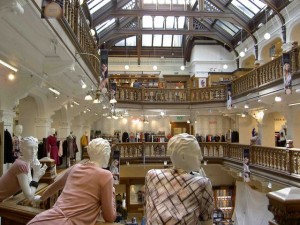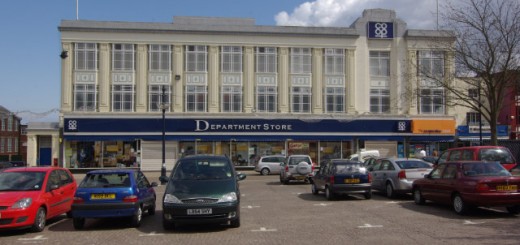New book examines the architectural history of Scotland’s shops
One of the nice things about running my own architecture subject gateway, Sapling.info, is that I get the opportunity to read about plenty of interesting buildings and places.
Earlier this week I paid a visit to the attractive and information-packed website of Historic Scotland, ahead of updating Sapling.info’s review of that site. While there, I was excited to see that the organisation has just published ‘Scotland’s Shops’, a 199-page book that examines the architectural history of shops in Scotland. My enthusiasm will hardly surprise you – regular readers of Soult’s Retail View will know by now that retail history is one of the areas that most interests me, even if my knowledge and coverage of Scotland, E&M aside, has been rather thin to date.
‘Scotland’s Shops’ certainly sounds like the kind of book that will be appearing on my bookcase before too long, though I was a little surprised to see that it’s not yet listed on Amazon.co.uk. It seems like I may have to have a go at ordering from Historic Scotland’s own web store instead.
The book itself has quite an interesting story behind it, being written by Dr Lindsay Lennie – an expert on the conservation of historic shops – as part of a three-year Research Fellowship funded by Historic Scotland.
The resulting publication apparently “explains the chronological history of the design of shops in Scotland, gives a technical background to the elements and materials used in their construction, as well as advice on their conservation, and also includes a gazetteer of retail buildings around Scotland.” In doing so, it “celebrates the history of Scotland’s retail architecture in a timeline from medieval markets to the post-war period”, featuring shops “from all around Scotland from Lerwick to Stranraer.”
Fiona Hyslop, the Scottish Minister for Culture, formally launched the book last week and rightly flagged up the importance of historic shops on various levels – whether for the stories underlying them, for the celebration of craftsmanship, or simply for their architectural delight:
“Traditional shops and shop fronts form the heart of many high streets across Scotland and play an important part in our history. Many long established family businesses and new owners who have inherited a shop with original tiling, shelving or a cast iron frontage are proud of the significance of these shops and want to ensure their survival for future generations to appreciate.
“Traditional Scottish building materials are also vital to the conservation and maintenance of our built heritage. Many towns and cities have their own distinctive and recognisable shop front styles. The fact that so many of them have survived across the country is testament to the quality and durability of the materials used to construct them and the skill with which they were used.
“Our shops form the economic and social building blocks of our town centres – they are woven into the social fabric of our towns and communities. Their architecture and conservation are of great importance in order to retain town centres that are individual, appealing and meaningful.”
Given the book’s celebration of Scottishness and individuality, there’s both logic and incongruity in it being launched at Jenners department store in Edinburgh’s Princes Street.
Operating from that site since 1838, it’s true that Jenners remains one of Scotland’s most iconic and well-known shops, with its baronial exterior and celebrated Grand Hall making it a must-see for any visitor to Edinburgh. On the other hand, House of Fraser’s purchase of Jenners in 2005 has meant that the store is no longer particularly individual, nor especially Scottish – House of Fraser may have been founded in Glasgow, but its corporate HQ has long been based in London.
I haven’t visited Jenners in Princes Street since the HoF takeover, though the much smaller branch at Loch Lomond Shores in Balloch, which I visited in 2008, did strike me as a rather odd combination of twee Scottish souvenirs against a backdrop of HoF own-brand and designer labels.
This battle to define what Jenners is and stands for – trying to reconcile its quirky, independent heritage with the shinier (but arguably less interesting) personality of its corporate parent – seems to continually vex retail commentators. Retail Week’s John Ryan, for example, earlier this year described Jenners in Princes Street as “failing to measure up” – “it may have the brands, the point of sale and the aspiration to match its sister store in Glasgow, but… it’s a rabbit warren [and] difficult to find your way around.” Even Mary Portas, the BBC’s Queen of Shops, has previously lamented what she sees as the store’s loss of individuality under HoF’s ownership:
“Jenners’ internal design is absolutely stunning, but it feels like House of Fraser got a hold of it and it’s just ended up with a slightly hybrid shop instead of one that is still ‘Jenners’. Now it doesn’t know what it is – Arthur or Martha.”
Perhaps more critical, however, is if the feelings of the retail gurus are shared by actual shoppers. Judging from the numerous comments on the Mary Portas article – “just another House of Fraser”, according to one reader, or “just Frasers with a higher price tag” by another – you get the impression that they could well be.
Scotland’s shops might indeed, as Fiona Hyslop contends, be “woven into the social fabric of our towns and communities.” However, lose what makes a store cherished in the first place and there’s always a danger that the stitching will start to come undone.
Thank you to Richard Webb and Steve F for the shots of Jenners. The photographs are © Copyright Richard Webb and © Copyright Steve F respectively, and both licensed for re-use under the Creative Commons Licence.















